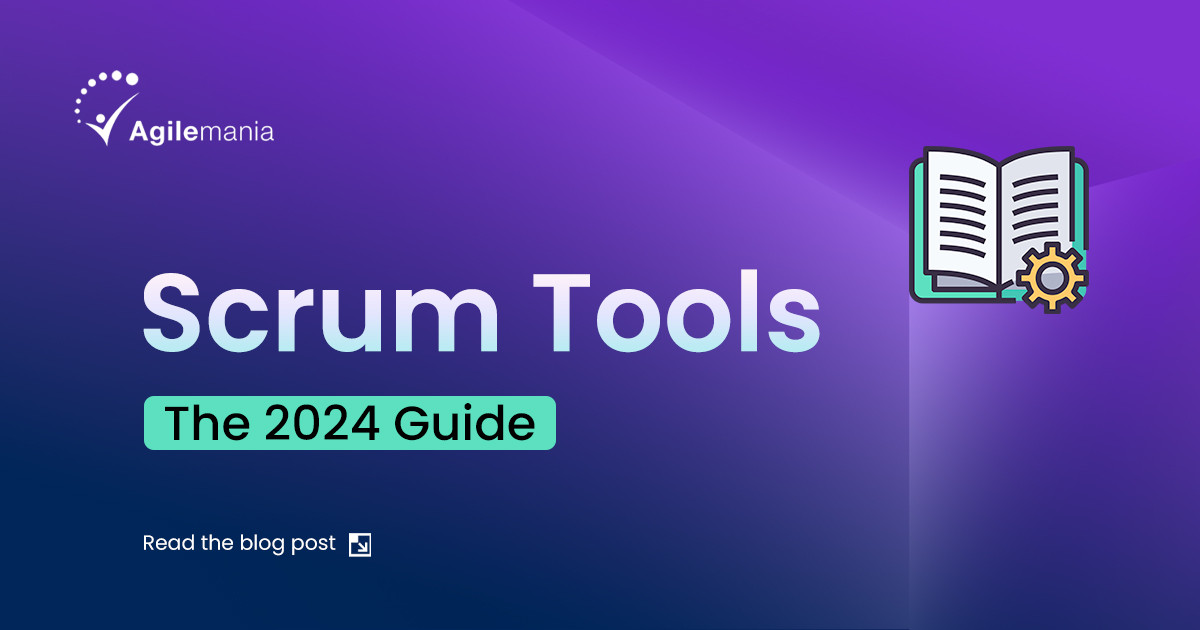
Agilemania
Agilemania, a small group of passionate Lean-Agile-DevOps consultants and trainers, is the most tru... Read more
![]() Get Your AI-Enabled Scrum Master Certification for Just ₹2,500 (Save 75%)!
Get Your AI-Enabled Scrum Master Certification for Just ₹2,500 (Save 75%)!
Scrum.Org
SAFe®
ICAgile
Scrum Alliance
Technical Agility
Kanban
Business Analysis
Project Management
AI-Enabled
Agilemania Academy
Scrum.Org
SAFe®
ICAgile
Scrum Alliance
Technical Agility
Kanban
Business Analysis
Project Management
AI-Enabled

Agilemania
Agilemania, a small group of passionate Lean-Agile-DevOps consultants and trainers, is the most tru... Read more

Scrum, a popular Agile project management framework, thrives on transparency, collaboration, and iterative development. But keeping all the moving parts organized can be a challenge. That's where Scrum tools come in - digital companions to streamline your workflow and empower your team to achieve more.
But what makes a great Scrum tool? Let’s have some patience. Before we figure that out, let’s have a look at the nitty-gritty of Scrum tools.
Scrum tools are software applications designed to specifically support the Scrum project management methodology. They essentially act as digital assistants to streamline your workflow and keep your Scrum team collaborative and productive.
Here's a breakdown of what Scrum tools are and how they help:
Think of them as Scrum helpers:
Scrum is a framework for breaking down large projects into smaller, more manageable chunks. Scrum tools assist this process by providing features for creating, prioritizing, and organizing your project backlog (to-do list).
Scrum relies on short work cycles called sprints. Scrum tools offer visual aids like Kanban boards and burndown charts to track progress within each sprint and help identify any roadblocks that might slow you down.
Communication is key in Scrum. Scrum tools provide features like team chat, file sharing, and real-time updates to keep everyone on the same page.
Scrum tools offer a wealth of benefits for project management within the Scrum framework. Here's a closer look at some of the key advantages.
There are different types of Scrum tools that cater to the various needs of a Scrum team. Here's a breakdown of the most common types:
These tools help create, prioritize, and manage your product backlog, which is essentially a list of all the features and functionalities that will be included in the final product.
Popular Backlog Management Tools: Jira Software , Trello
These facilitate the planning and tracking of sprints, which are short, time-boxed periods (usually 2-4 weeks) where development work is completed.
Kanban boards are a popular feature that visualize the workflow of tasks within a sprint. These boards typically have columns representing different stages of completion (e.g., To Do, In Progress, Done). Burndown charts are another helpful tool that track the remaining work in a sprint over time.
Popular Sprint Planning & Tracking Tools: Asana , Monday.com
These promote communication and knowledge sharing among team members. Features like team chat, file sharing, and real-time updates help keep everyone informed and on the same page.
Popular Collaboration Tools: Slack , Microsoft Teams
These generate reports and dashboards that provide valuable insights into team velocity, identify trends, and measure project progress. This data allows project managers and stakeholders to make informed decisions throughout the project lifecycle.
Popular Reporting & Metrics Tools: ClickUp , Wrike
Choosing the right Scrum tool depends on your team's specific needs and preferences. Consider factors like team size, budget, technical expertise, and desired level of functionality. Many Scrum tools offer free trials, so take advantage of them to experiment and find the perfect fit for your team.

Here's a breakdown of 5 popular Scrum tools and their key features to help you choose the right one for your team:
Key Features:
Robust Backlog Management: Prioritize, assign, and track user stories, bugs, and other backlog items.
Advanced Sprint Planning: Visually plan sprints with burndown charts, Kanban boards, and customizable workflows.
Agile Reporting: Generate insightful reports on team velocity, sprint progress, and project health.
Integrations: Integrates with other Atlassian products for a comprehensive Agile toolkit (e.g., Confluence for team collaboration).
Best For: Teams looking for a powerful and scalable solution with extensive features for complex projects.
Key Features:
Simple and Intuitive Kanban Boards: Drag-and-drop functionality allows for easy task visualization and workflow management.
Team Collaboration: Built-in features like comments, file attachments, and card mentions facilitate communication.
Power-Ups (Add-ons): Extend Trello's functionality with various integrations and power-ups for automation, time tracking, etc.
Free Plan Available: A free plan with basic features makes it a good option for smaller teams or those starting with Scrum.
Best For: Teams who value simplicity and ease of use for visualizing workflows and managing tasks.
Key Features:
Flexible Task Management: Create tasks, subtasks, and dependencies to break down projects into manageable chunks.
List, Board, and Calendar Views: Choose the view that best suits your team's needs for task visualization.
Team Communication: Built-in commenting and messaging features keep everyone informed and aligned.
Reporting and Tracking: Track progress over time and identify roadblocks with project overviews and reports.
Best For: Teams looking for a well-rounded project management tool with strong task management capabilities and a user-friendly interface.
Key Features:
All-in-one Solution: Combines features for task management, sprint planning, time tracking, communication, and goal setting.
Highly Customizable: Create custom views, workflows, and automations to fit your team's specific needs.
Whiteboards and Mind Maps: Facilitate brainstorming and collaborative planning sessions.
Free Forever Plan: A free plan with limitations caters to smaller teams or those on a budget.
Best For: Teams seeking a comprehensive solution for managing all aspects of their Scrum projects in one place.
Key Features:
Visually Appealing Dashboards: Create customizable dashboards to track progress, KPIs, and team performance.
Multiple Board Views: Choose from Kanban boards, Gantt charts, or other views to visualize your workflow.
Automations: Automate repetitive tasks like assigning work, sending notifications, and updating progress.
Integrations: Connects with various third-party tools to streamline workflows further.
Best For: Teams who value a user-friendly interface with strong visual elements and automation capabilities.
Remember, the best Scrum tool depends on your specific needs. Consider factors like team size, budget, desired features, and complexity of your projects when making your choice.
The right scrum tool can be the engine that propels your agile team to success. Remember, the ideal tool should complement your team's unique style and needs. Don't be afraid to experiment and find the perfect fit. As the world of project management continues to evolve, so too will scrum tools. Stay informed about the latest advancements and embrace the opportunities they present.
While spreadsheets and whiteboards can work for small, simple projects, Scrum tools offer significant advantages. They automate tedious tasks, improve transparency, and provide valuable data for informed decision-making. As your project grows in complexity, a Scrum tool can become essential for keeping everything organized and on track.
Many Scrum tools offer a user-friendly interface and basic functionalities that are perfect for teams getting started with Scrum. Trello, with its simple Kanban boards, and Asana, with its intuitive task management features, are great options for beginners.
For remote teams, strong collaboration features are crucial. Look for tools with built-in chat, real-time updates, video conferencing capabilities, and document sharing options. Tools like Slack or Microsoft Teams can integrate seamlessly with your Scrum tool for enhanced communication.
Many Scrum tools offer integrations with popular project management and communication tools. This allows you to consolidate your workflow and avoid data silos. Tools like Jira Software or ClickUp have extensive integration options to fit into your existing ecosystem.
Reputable Scrum tools prioritize user data security. Look for tools with features like two-factor authentication, role-based access control, and encrypted data storage. It's also important to choose a tool with a proven track record of security and compliance with relevant data protection regulations
Agilemania, a small group of passionate Lean-Agile-DevOps consultants and trainers, is the most trusted brand for digital transformations in South and South-East Asia.
WhatsApp Us
We will get back to you soon!
For a detailed enquiry, please write to us at connect@agilemania.com

